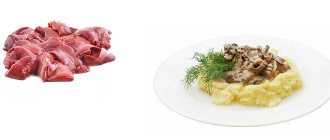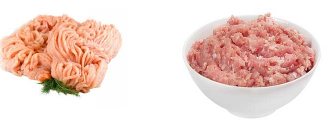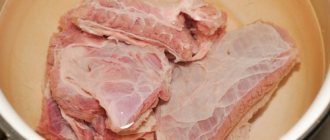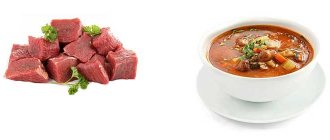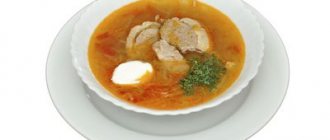© photocrew – stock.adobe.com
Share:
Beef is the meat of cattle, which is subjected to various processing methods, including heat. Many dishes are prepared from this product: first and second courses, appetizers, sausages, etc. Beef is an amazing meat that, when consumed in moderation and wisely, brings great benefits to the human body. Meat is especially useful for those who watch their figure and play sports. To avoid health problems, you should be aware of the calorie content of the product and contraindications to its use. You will learn about this and much more from our article.
Calorie content and amount of proteins, fats and carbohydrates
100 grams of product contains about 192-195 calories. BJU is 19, 12, 0 grams, respectively.
The vitamin and mineral complex includes:
- Elastin and collagen (maintain skin elasticity, youth and radiance).
- Iron.
- Zinc.
- Manganese.
- Copper.
- Selenium.
- Sodium.
- Calcium.
- Phosphorus.
- Magnesium.
- Potassium.
- Folic acid.
- Niacin.
- Pantothenic acid.
- Vitamins of group B, K.
This is most of the substances that beef contains. All of them are vital for every human body.
Features of lean beef
Meat products labeled lean beef must have a minimal amount of fat. Meat should have no more than 10 percent fat, although some varieties have as little as 5 percent. Cholesterol should not be more than 95 milligrams per 100 grams of product.
In fact, thanks to improvements in cattle breeding and feeding, as well as improved trimming techniques, more than 60 percent of cuts of meat found in the supermarket are considered lean when they are prepared with visible fat trimmed.
Boiled beef
Pan-fried beef brisket and shoulder sirloin are ideal for boiling. When cooked, the tough connective tissue between muscle fibers is destroyed. This process causes the beef to shrink, soften and absorb the flavor of the cooking liquid and any spices included in it.
Boiled beef is the perfect Sunday dinner because once cooked, the meat can be reused in any quantity for individual meals throughout the week. The boiled dish retains many beneficial substances. It is especially good to steam meat.
Beef calories
Beef is considered one of the least calorie types of meat, but energy values differ. This is due to two reasons:
- the number of calories is affected by what part of the carcass is taken (breast, fillet, thigh, neck, offal, etc.);
- what method of heat treatment the meat was subjected to (stewing, boiling, baking, frying).
Let's talk about everything in order. The carcass of a cow or bull is butchered differently in all countries of the world. In our country, they are cut into the following parts: neck, brisket, thin and thick edge, sirloin (loin), tenderloin, peritoneum (flank), shoulder, rump, thigh, flank, rump, shank. These parts of the carcass are classified into three classes:
- First grade - breast and back parts, rump, rump, fillet, sirloin. This variety is also called superior.
- The second grade is the shoulder parts and shoulder blades, as well as the flank.
- The third grade is front and back shanks.
© bit24 – stock.adobe.com
Such meat can be lean (no fat at all), lean, or fatty. As mentioned earlier, the caloric content of all parts of the carcass is different. You can see the total number of calories and energy value of fresh pieces in the table below.
| Raw part of the carcass | Calorie content per 100 g | Energy value (BZHU) |
| Hip | 190 kcal | 34 g protein, 4 g fat, 9.7 g carbohydrates |
| Tenderloin | 182 kcal | 19.7 g protein, 11 g fat, no carbohydrates |
| shank | 196 kcal | 18 g protein, 7 g fat, no carbohydrates |
| Brisket | 217 kcal | 19 g protein, 15.7 g fat, no carbohydrates |
| Kostrets | 218 kcal | 18.6 g protein, 16 g fat, 0.4 g carbohydrates |
| Spatula | 133 kcal | 18.7 g protein, 6.5 g fat, no carbohydrates |
| Rump | 123 kcal | 20 g protein, 4.5 g fat, 0.2 g carbohydrates |
| Ribs | 236 kcal | 16.4 g protein, 19 g fat, no carbohydrates |
| Thick edge | 164 kcal | 19 g protein, 10 g fat, 0.5 g carbohydrates |
| Thin edge | 122 kcal | 21 g protein, 4 g fat, no carbohydrates |
| Fillet | 200 kcal | 23.5 g protein, 7.7 g fat, no carbohydrates |
| Neck | 153 kcal | 18.7 g protein, 8.4 g fat, no carbohydrates |
| Bone marrow | 230 kcal | 10 g protein, 60 g fat, 20 g carbohydrates |
| Lungs | 92 kcal | 16 g protein, 2.5 g fat, no carbohydrates |
| Brain | 124 kcal | 11.7 g protein, 8.6 g fat, no carbohydrates |
| Liver | 135 kcal | 20 g protein, 4 g fat and carbohydrates each |
| Kidneys | 86 kcal | 15 g protein, 2.8 g fat, no carbohydrates |
| Heart | 96 kcal | 16 g protein, 5.5 g fat, no carbohydrates |
| Language | 146 kcal | 12 g protein, 10 g fat, no carbohydrates |
As you can see, there really is a difference and in some cases significant. For example, an offal such as bone marrow is higher in calories than beef tenderloin, shank, thighs, and brisket. The calorie content of different parts varies depending on how you prepare them: cook in a slow cooker, fry on the grill, stew with vegetables in a frying pan, bake in the oven in foil or a sleeve, steam, etc. There will be a difference even in cooking with or without salt, and also in whether you choose a piece of pure pulp or take meat on the bones.
For example, 100 g of raw fillet contains 200 kcal, boiled fillet - 220, stewed - 232, fried - 384, but baked - 177, steamed - 193. The difference in this case is small, but in smoked, dried, dried form, the number of calories increases significantly: smoked fillet contains 318 kcal, dried fillet - 410, dried - 292. So, when calculating the calorie content of beef, you should take into account which part was chosen and how it will be cooked. These two points are important in calculating the energy value of meat.
Useful properties of beef
- Beef contains complete, easily digestible proteins that are of great importance in the human diet. The highest amount of protein is found in beef tenderloin (the softest part of the carcass).
- Beef also contains many trace elements (magnesium, zinc, calcium, potassium, iron, phosphorus, sodium), which strengthen the musculoskeletal system and vitamins: group (good for the visual organs), PP (part of the enzymes), C (strengthens the walls of blood vessels ), B6 and B12 (actively involved in the absorption of iron).
- After cooking, meat promotes recovery from injuries, infectious diseases and burns.
- It contains a small amount of fat and is considered lean. This quality makes it ideal for dieters and athletes.
Chemical composition and benefits of the product
The benefits of beef are due to its rich chemical composition. It contains vitamins, minerals, micro- and macroelements, amino acids and other biologically active substances. Beef contains the following vitamins: A, E, C, K, D. B vitamins in red meat are represented by a wide list: B1, B2, B3, B4, B5, B6, B12.
There is a sufficient amount of amino acids in beef: glutamic, aspartic, tryptophan, lysine, leucine, threonine, methionine, cystine, phenylalanine, alanine, glycine, proline, serine. Beef is rich in useful microelements (iron, iodine, fluorine, copper, nickel, cobalt, molybdenum, chromium, tin, zinc, manganese) and macroelements (potassium, calcium, magnesium, chlorine, sodium, sulfur, phosphorus).
© Andrey Starostin – stock.adobe.com
These substances individually have a beneficial effect on certain areas of the body, and together they improve overall health. Beef is a satisfying, nutritious and low-calorie product. The main beneficial property of this meat is the presence of complete animal protein, which is easily digestible. For this reason, professional athletes and just people trying to keep in shape prefer beef. Animal protein helps saturate the cells of the human body with oxygen. The greatest amount of protein is found in such a part of the cattle carcass as tenderloin. At the same time, there is very little fat in red meat: there is even less fat in beef than in chicken, and even more so in pork and lamb.
Let's now talk in more detail about the positive effects of the vitamins contained in beef. What are their benefits? How do they affect the body?
The beneficial properties of red meat due to its vitamin composition are as follows:
- Vitamin A is a faithful assistant in solving vision problems. This substance, like vitamin C, is a natural antioxidant that has a positive effect on the status of the body’s immune system. Vitamin A has a beneficial effect on the nervous system, resists depression, insomnia, stress, and has a positive effect on the skin and the condition of nails and hair.
- B vitamins have an effect on all organs and systems. It cannot do without a beneficial effect on the nervous, cardiovascular, immune, and circulatory systems. The compounds give the body a boost of energy and vigor. Not only does a person’s physical condition improve, but also their mental state; one feels a surge of strength and a desire to lead an active lifestyle.
- Vitamin C is a reliable protection against viruses and bacteria. This antioxidant prevents germs from entering the body. To ensure good health and prevent a person from contracting infectious diseases, it is recommended to take vitamin C.
- Vitamin D - essential for strong bones, muscles and teeth. It is especially necessary for children during the period of growth and development of the body. Vitamin D improves coordination of movements, has a calming effect on the nervous system, and helps strengthen the immune system.
- Vitamins E and K - affect the functioning of the circulatory system, improve blood clotting and dilate blood vessels. They also restore hormonal levels in women and improve potency in men. Vitamin E is what couples who want to have a child need. For women, the substance is recommended to normalize the menstrual cycle.
Not only vitamins, but also micro- and macroelements contained in beef have a beneficial effect on the nervous system. Together, these substances have a positive effect: the risk of depression, neuroses, insomnia and other somnological disorders is reduced. Microelements counteract stress, reduce their impact on the body, develop resistance to external stimuli and a calm perception of the world around us.
Beef is a preventative against atherosclerosis. Red meat dishes are recommended to be consumed to strengthen the walls of blood vessels, which helps fight cardiac disorders. The compounds contained in beef tend to remove unnecessary cholesterol from the body. They normalize the acidity level of gastric juice, which is important for the functioning of all organs of the gastrointestinal tract.
The work of the pancreas, stomach, and intestines comes into order, and problems such as constipation, diarrhea, flatulence, and bloating recede. The substances contained in beef fight infectious diseases, which is why dishes made from this red meat are recommended for consumption by people recovering from illness, injury and surgery.
As you can see, the benefits of beef for human health are truly enormous. There is no system or organ that is not affected by the vitamins and other beneficial substances contained in this product. The organs of vision, bones, nails, teeth, hair, immune, nervous, circulatory, cardiovascular, endocrine systems - all this is strengthened and improved by consuming boiled (boiled), stewed, baked, dried beef of all types (tenderloins, fillets, thighs , brisket, liver, kidneys, bone marrow).
Beef in diets, its medicinal properties
Research shows that eating lean beef as part of a balanced diet supports healthy blood pressure and blood lipid levels. A diet lower in sodium and high in potassium and lean protein helps lower blood pressure.
Beef is the leading source of potassium in the diet of citizens. Research also suggests that partially replacing carbohydrates in the diet with protein may be a useful strategy for preventing hypertension and cardiovascular disease.
This meat pairs perfectly with fruits and vegetables such as zucchini, corn, pineapple and plums, which add delicious flavor to a nutrient-rich meal. Research shows that higher dietary intake of L-carnitine may have positive health effects. This component is found in beef.
This helps protect every cell of the body from cellular damage (rupture, microcracks), which can lead to many chronic diseases (heart, musculoskeletal system, liver and kidneys, joints, intestines).
Contraindications for use
Here are a few that are particularly important:
- Excessive consumption of beef (especially mature beef) contributes to a decrease in immunity.
- Meat contains purine compounds, which means it promotes the accumulation of uric acid (can cause gout, osteochondrosis, urolithiasis).
- May cause problems with the intestines (even the development of plaques in the colon), kidneys and heart.
- Increases cholesterol levels.
The negative impact increases in old age. It is recommended to consume beef in moderation.
Beef varieties
Beef varieties are distinguished by their cut.
Here are the most used:
- Rump: cut from the shoulder (tough but flavorful).
- Shank: Cut from the leg (very tough and chewy).
- Brisket: Cut from the breast (tough if not cooked correctly).
- Rib: cut from the rib area (very tender and flavorful).
- Belly: Cut from the belly of a cow (chewy and quite tough).
- Sides: carved from the abdominal muscles of a cow (the toughest).
- Loin: cut in the back of the cow above the ribs (most tender).
- Filet: Tenderloin just near the loin (quite tender and flavorful).
- Hindquarter: Cut from the hindquarters of the cow above the hind legs (chewy and firm).
There are less common cuts that are not very popular:
- Language.
- Neck.
- Leg.
- Liver: liver and other internal organs.
Many people believe that less common meats are less desirable when it comes to taste and texture. For example, many people don't like the texture or taste of beef liver, so they never buy it at the store, despite its high level of vitamins and minerals.
Beef for weight loss and sports nutrition
Introducing beef into your diet for the purpose of losing weight or as an element of sports nutrition is a great solution, because the product has a lot of useful properties. Red meat from cattle is one of the least high-calorie meats, which is why it is recommended for people who want to lose a few extra pounds.
Beef is healthier in this regard than chicken. For this reason, red meat is an ideal protein base for lunch or dinner. You just need to supplement the product with vegetables - and your meal will be healthy, balanced and rich in nutrients. Such food will give you a feeling of satiety, normalize metabolism and become a faithful assistant in the fight against excess weight.
© Mikhaylovskiy – stock.adobe.com
Why is beef recommended for dietary nutrition? The answer is simple: this type of meat has little fat and no carbohydrates at all. At the same time, the product is rich in vitamins and minerals, which improve metabolic processes in the body, which leads to getting rid of excess weight. Fat burning occurs faster by consuming natural protein, which is easily digestible.
The main thing is to cook the meat correctly. It is better to boil, bake or stew it, since in this case the beneficial substances are retained in the composition. Moreover, after such heat treatment, the number of calories in the product remains low.
Advice! If you are hoping to lose weight with beef, do not fry it under any circumstances, especially in oil. Firstly, it is harmful, and secondly, meat prepared in this way contains many more calories than boiled, stewed or baked meat. The calorie content of fried beef is almost twice as high as the listed heat treatment options.
Beef is prized by athletes and bodybuilders. This is due to the composition of the meat. Vitamins and amino acids are needed to restore strength after heavy physical activity and grow muscle mass. Vitamin B12, protein, iron, zinc, folic acid, calcium - these substances contribute to the rapid gain of muscle weight. Red meat is also rich in creatine, the positive properties of which are known to all athletes. For this reason, nutritionists recommend that people who want to build muscle eat 1-2 grams of beef for every kilogram of body weight.
Athletes and bodybuilders are better off focusing on the following parts of the carcass: fillet, back, tenderloin. It is better to stew the first one or bake it in the oven, since this meat is tougher, and the second and third ones should be boiled or grilled, since the tenderloin and back are the softest pieces.
